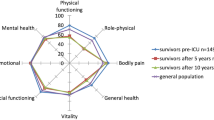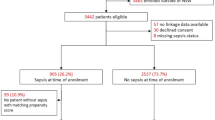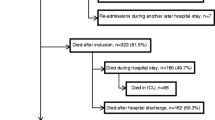Abstract
Purpose
Severe critical illness requiring treatment in the intensive care unit (ICU) may have a serious impact on patients and their families. However, optimal follow-up periods are not defined and data on health-related quality of life (HRQOL) before ICU admission as well as those beyond 2 years follow-up are limited. The aim of our study was to assess the impact of ICU stay up to 5 years after ICU discharge.
Methods
We performed a long-term prospective cohort study in patients admitted for longer than 48 h in a medical-surgical ICU. The Short-Form 36 was used to evaluate HRQOL before admission (by proxy within 48 h after admission of the patient), at ICU discharge, and at 1, 2, and 5 years following ICU discharge (all by patients). Changes in HRQOL were assessed using linear mixed modeling.
Results
We included a total of 749 patients (from 2000 to 2007). At 5 years after ICU discharge 234 patients could be evaluated. After correction for natural decline in HRQOL, the mean scores of four dimensions—physical functioning (p < 0.001), role-physical (p < 0.001), general health (p < 0.001), and social functioning (p = 0.003)—were still significantly lower 5 years after ICU discharge compared with their pre-admission levels, although effect sizes were small (<0.5).
Conclusions
After correction for natural decline, the effect sizes of decreases in HRQOL were small, suggesting that patients regain their age-specific HRQOL 5 years after their ICU stay.


Similar content being viewed by others
Abbreviations
- APACHE II:
-
Acute physiology and chronic health evaluation
- BP:
-
Bodily pain
- CAM-ICU:
-
Confusion assessment method for the ICU
- EQ-5D:
-
EuroQol-5-D
- GH:
-
General health
- HRQOL:
-
Health-related quality of life
- ICU:
-
Intensive care unit
- IQR:
-
Interquartile range (P 25–P 75)
- LOS:
-
Length of stay
- MCS:
-
Mental component score
- MH:
-
Mental health
- PCS:
-
Physical component score
- PF:
-
Physical functioning
- RE:
-
Role limitation due to emotional problems
- RP:
-
Role limitation due to physical problems
- SF:
-
Social functioning
- SF-36:
-
Medical Outcomes Study 36-item short form
- VT:
-
Vitality
References
Combes A, Costa MA, Trouillet JL, Baudot J, Mokhtari M, Gilbert C et al (2003) Morbidity, mortality, and quality-of-life outcomes of patients requiring > or = 14 days of mechanical ventilation. Crit Care Med 31:1373–1381
Cuthbertson BH, Scott J, Strachan M, Kilonzo M, Vale L (2005) Quality of life before and after intensive care. Anaesthesia 60:332–339
Eddleston JM, White P, Guthrie E (2000) Survival, morbidity, and quality of life after discharge from intensive care. Crit Care Med 28:2293–2299
Flaatten H, Kvale R (2001) Survival and quality of life 12 years after ICU. A comparison with the general Norwegian population. Intensive Care Med 27:1005–1011
Niskanen M, Ruokonen E, Takala J, Rissanen P, Kari A (1999) Quality of life after prolonged intensive care. Crit Care Med 27:1132–1139
Ridley SA, Chrispin PS, Scotton H, Rogers J, Lloyd D (1997) Changes in quality of life after intensive care: comparison with normal data. Anaesthesia 52:195–202
Graf J, Koch M, Dujardin R, Kersten A, Janssens U (2003) Health-related quality of life before, 1 month after, and 9 months after intensive care in medical cardiovascular and pulmonary patients. Crit Care Med 31:2163–2169
Wu A, Gao F (2004) Long-term outcomes in survivors from critical illness. Anaesthesia 59:1049–1052
Black NA, Jenkinson C, Hayes JA, Young D, Vella K, Rowan KM et al (2001) Review of outcome measures used in adult critical care. Crit Care Med 29:2119–2124
Kaarlola A, Pettila V, Kekki P (2003) Quality of life six years after intensive care. Intensive Care Med 29:1294–1299
Stricker KH, Sailer S, Uehlinger DE, Rothen HU, Zuercher Zenklusen RM, Frick S (2011) Quality of life 9 years after an intensive care unit stay: a long-term outcome study. J Crit Care 26:379–387
Herridge MS, Tansey CM, Matte A, Tomlinson G, Diaz Granados N, Cooper A et al (2011) Functional disability 5 years after acute respiratory distress syndrome. N Engl J Med 364:1293–1304
Cuthbertson BH, Roughton S, Jenkinson D, Maclennan G, Vale L (2010) Quality of life in the five years after intensive care: a cohort study. Crit Care 14:R6
Knaus WA, Draper EA, Wagner DP, Zimmerman JE (1985) APACHE II: a severity of disease classification system. Crit Care Med 13:818–829
Ware JE Jr, Sherbourne CD (1992) The MOS 36-item short-form health survey (SF-36). I. Conceptual framework and item selection. Med Care 30:473–483
Ware JE (1993) Health survey manual and interpretation guide. Medical Outcomes Trust, Boston
Ware JE, Kosinski M (2001) Interpreting SF-36 summary health measures: a response. Qual Life Res 10:405–413
Brazier JE, Harper R, Jones NM, O’ Cathain A, Thomas KJ, Usherwood T et al (1992) Validating the SF-36 health survey questionnaire: new outcome measure for primary care. BMJ 305:160–164
Chrispin PS, Scotton H, Rogers J, Lloyd D, Ridley SA (1997) Short Form 36 in the intensive care unit: assessment of acceptability, reliability and validity of the questionnaire. Anaesthesia 52:15–23
Heyland DK, Hopman W, Coo H, Tranmer J, McColl MA (2000) Long-term health-related quality of life in survivors of sepsis. Short Form 36: a valid and reliable measure of health-related quality of life. Crit Care Med 28:3599–3605
Jenkinson C, Coulter A, Wright L (1993) Short Form 36 (SF36) health survey questionnaire: normative data for adults of working age. BMJ 306:1437–1440
Aaronson NK, Muller M, Cohen PD, Essink-Bot ML, Fekkes M, Sanderman MA et al (1998) Translation, validation, and norming of the Dutch language version of the SF-36 health survey in community and chronic disease populations. J Clin Epidemiol 51:1055–1068
Hofhuis J, Hautvast JL, Schrijvers AJ, Bakker J (2003) Quality of life on admission to the intensive care: can we query the relatives? Intensive Care Med 29:974–979
Hofhuis JG, Dijkgraaf MG, Hovingh A, Braam R, van de Braak L, Spronk PE, et al (2011) The Academic Medical Center Linear Disability Score for evaluation of physical reserve on admission to the ICU: can we query the relatives? Crit Care 15:R212
Hofhuis JG, Spronk PE, van Stel HF, Schrijvers GJ, Rommes JH, Bakker J (2008) The impact of critical illness on perceived health-related quality of life during ICU treatment, hospital stay, and after hospital discharge: a long-term follow-up study. Chest 133:377–385
Twisk, Jos WR (2003) Applied longitudinal data analysis for epidemiology. Cambridge University, UK
Cohen J (1988) Statistical power analysis for the behavioral sciences. Lawrence Erlbaum Associates, NJ
Oeyen SG, Vandijck DM, Benoit DD, Annemans L, Decruyenaere JM (2010) Quality of life after intensive care: a systematic review of the literature. Crit Care Med 38:2386–2400
Hofhuis JG, Spronk PE, van Stel HF, Schrijvers AJ, Bakker J (2007) Quality of life before intensive care admission is a predictor of survival. Crit Care 11(4):R78
Nesseler N, Defontaine A, Launey Y, Morcet J, Malledant Y, Seguin P (2013) Long-term mortality and quality of life after septic shock: a follow-up observational study. Intensive Care Med 39:881–888
Jones C (2013) What’s new on the post-ICU burden for patients and relatives? Intensive Care Med 10:1832–1835
Schelling G, Stoll C, Vogelmeier C, Hummel T, Behr J, Kapfhammer HP et al (2000) Pulmonary function and health-related quality of life in a sample of long-term survivors of the acute respiratory distress syndrome. Intensive Care Med 26:1304–1311
Berkius J, Engerstrom L, Orwelius L, Nordlund P, Sjoberg F, Fredrikson M et al (2013) A prospective longitudinal multicentre study of health related quality of life in ICU survivors with COPD. Crit Care 17:R211
Orwelius L, Fredrikson M, Kristenson M, Walther S, Sjoberg F (2013) Health-related quality of life scores after intensive care are almost equal to those of the normal population: a multicenter observational study. Crit Care 17:R236
Hopman WM, Berger C, Joseph L, Towheed T, VandenKerkhof E, Anastassiades T et al (2006) The natural progression of health-related quality of life: results of a five-year prospective study of SF-36 scores in a normative population. Qual Life Res 15:527–536
Skinner EH, Warrillow S, Denehy L (2011) Health- related quality of life in Australian survivors of critical illness. Crit Care Med 39:1896–1905
Schweickert WD, Pohlman MC, Pohlman AS, Nigos C, Pawlik AJ, Esbrook CL et al (2009) Early physical and occupational therapy in mechanically ventilated, critically ill patients: a randomised controlled trial. Lancet 373:1874–1882
Rogers J, Ridley S, Chrispin P, Scotton H, Lloyd D (1997) Reliability of the next of kins’ estimates of critically ill patients’ quality of life. Anaesthesia 52:1137–1143
Scales DC, Tansey CM, Matte A, Herridge MS (2006) Difference in reported pre-morbid health-related quality of life between ARDS survivors and their substitute decision makers. Intensive Care Med 32:1826–1831
Sprangers MA, Schwartz CE (1999) Integrating response shift into health-related quality of life research: a theoretical model. Soc Sci Med 48:1507–1515
Conflicts of interest
The authors declare that they have no competing interest.
Author information
Authors and Affiliations
Corresponding author
Additional information
Take home message: After correction for natural decline, the effect sizes of decreases in HRQOL were small, suggesting that patients regain their age specific HRQOL 5 years after their ICU stay.
Electronic supplementary material
Below is the link to the electronic supplementary material.
Rights and permissions
About this article
Cite this article
Hofhuis, J.G.M., van Stel, H.F., Schrijvers, A.J.P. et al. ICU survivors show no decline in health-related quality of life after 5 years. Intensive Care Med 41, 495–504 (2015). https://doi.org/10.1007/s00134-015-3669-5
Received:
Accepted:
Published:
Issue Date:
DOI: https://doi.org/10.1007/s00134-015-3669-5




